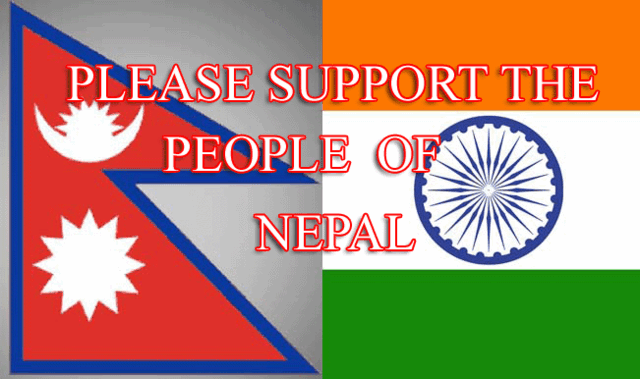 |
"We, at Ahimsa Foundation are deeply shocked and saddened by the 7.8 magnitude earthquake that struck Nepal as well as its surrounding areas on 25th April 2015. We wish to convey our deepest condolences to the peoples of Nepal affected by the earthquake. We are deeply saddened by the loss of lives and damages to properties and infrastructures as well as historical heritage sites in the capital of Kathmandu and its surrounding areas. Our thoughts are with all those who have lost loved ones and the many thousands who have been left homeless as a result of this tragedy." |
KUTCHI JAINS DONATE FOR ANIMAL WELFARE AND NEPAL EARTHQUAKE
April 28, 2015. Rs. 2.50 crore donation for fodder and water supply to cattle in scarcity-hit Kutch district of Gujarat was announced in a function at Dombivali in Mumbai. And this was not just merely an announcement. Rs. 2.50 crore cheque was handed over by Kutchi Jain Foundation-Mumbai to Minister of State, Government of Gujarat Shri Tarachand Chheda on the spot. The function was held on the occassion of Pran Pratishtha Mahotsav of Muni Suvrat Swami Jain Derasar. Inspired by Bhagavant Kalaprabhusagar Surishwarji Maharaj Saheb, local Kutchi Jain community leaders also donated Rs. 1 crore for Nepal earthquake victims. Rs. 8 crore fund was collected on the spot for Jain Gurukul in Dombivali. Community leaders Dungarshi Gala, Chandrakant Goghari, Bipin Gangar, Bipil Gala, Jadavji Enchorvala, Vishanji Soni etc were present on this occasion.
JAINA APPEALS ITS MEMBERS TO CONTRIBUTE FOR NEPALJAINA
 |
World Community Service launched a fund for the victims of earthquake tragedy. It is issued appeal to its members for sending contributions. The funds will be used for a humanitarian project that will be selected & executed against once the relief operations ends and rehabilitation work begins. According to Jains Spokesperson, “JAINA always gets involved and provides a helping hand whenever and wherever a disaster strikes. Our volunteers work directly in the affected area to deliver aid, keeping in mind Jain principles. Our efforts are always directed towards projects with long term benefits like building a school, hospital, housing or a rehabilitation center. Previously, we have raised over $50,000 for Haiti Earthquake $200,000 for the Tsunami victims, and $750,000 for the Gujarat earthquake. Jains in North America have always shown our generosity all over the world, as steadfast believers of Jiv Daya and Ahimsa”. For further information: www.jaina.org/donations
AHIMSA & VEGETARIANISM
JAIN TRUST BEHIND THE BAN LEGISLATION IN MAHARASHTRA
For Animal lovers, Maharashtra’s recent extension of the ban on cow slaughter to bulls and bullocks was a landmark victory. For a small Jain trust in the Mumbai neighborhood of Borivali, the controversial beef ban is just the beginning of a long fight for a return to an ideal world of sustainable, non-mechanised agriculture.
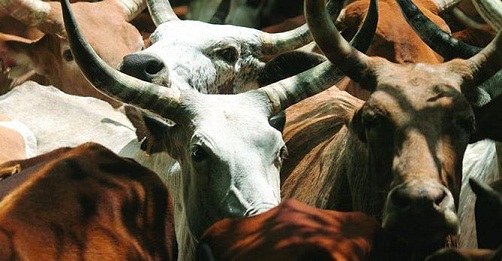 |
The Viniyog Trust convinced the state government to make cattle slaughter a non-bailable crime. The Viniyog Parivar Trust claims it is dedicated to “saving the precious cattle bank of the country”. Its intervention in the beef ban legislation has been responsible for some of the most controversial aspects of the Maharashtra Animal Preservation Act, 1976, which was amended and passed by the assembly on March 3.
In 1995, when the BJP-Shiv Sena government in the state first introduced the Act, the Viniyog Trust helped frame at least three important clauses that give it more teeth than the government had originally intended. It is because of the Trust, for instance, that the slaughter of cows, bulls and bullocks is now a non-bailable offence. To ensure that animals from Maharashtra are not exported to other states for slaughter, it also pushed for the ban on the export of cattle.
Finally, it was the Trust’s idea to include a provision that shifts the burden of proving the crime of cattle slaughter from the prosecuting state to the accused. The Viniyog Trust is also working towards an extended beef ban at a national level. "We are campaigning nationally and are in touch with the Prime Minister's Office," said Joshi, who is banking on the BJP-led government to bring about a change in national laws.
Acharya Dr. Lokesh Muni also made concrete efforts for implementation of law to ban cow slaughtering in Maharashtra and Haryana. Acharya Lokesh has been constantly working for establishment of non-violence. In this regards bill to ban cow slaughtering was pending with President of India since 1996. After many meetings between Acharya Dr. Lokesh Muni Ji and Honorable President of India Dr. Pranab Mukherjee bill pending from 19 years against cruelty to animals was passes in Maharashtra state and law to save cows was implemented.
After Maharashtra Acharya Dr. Lokesh Muni made efforts to ban cow slaughtering in Haryana. After many meetings between Acharya Dr. Lokesh Muni Ji and Honorable Chief Minister of Haryana Shri Manohar Lal Khattar and Chief Minister’s participation in Shri Virchad Ragahv Ji Gandhi 150th Birth Anniversary celebrations bill against cow slaughtering was passed in Haryana State Assembly and law was implemented in whole state.
DELHI NDMC ELECTRIC FENCING TO KEEP AWAY MONKEYS
NDMC officials said the electric wires have been installed in VVIP areas such as Shastri Bhawan and North Block. As this amounts to clear cut case of cruelty against animals Ahimsa Mahasangh, a Gujarat-based Animal Rights Group has issued a legal notice to NDMC and desired that this fencing be removed.
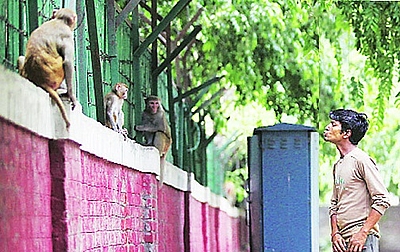 |
While affirming that it has been served a notice, NDMC officials maintained that the measures taken by them are completely safe. “This group has claimed that this measure violates the Wildlife Protection Act. However, these steps are completely safe. The intensity of the current in these wires is quite low and not lethal,” a senior NDMC official said. The council has been asked to reply to the notice in a month’s time. According to NDMC officials, the notice stated that the electric shock will harm the monkeys and this was in violation of the Wildlife Protection Act. “Tests were conducted before these wires were installed. Monkeys will not get injured because the wires emit a low-voltage shock,” the official said. NDMC officials said the electric wires have been installed in VVIP areas such as Shastri Bhawan and North Block. “For a very long time, we have been receiving complaints about offices being vandalised by monkeys. We have tried different measures to curb the menace and we finally installed wires around important offices to keep monkeys away,” the official said. From using rubber bullets, providing food to monkeys in forested areas to employing a group of forty people dressed as langurs, the civic body has tried a range of steps to curb the monkey menace. Despite these initiatives, the NDMC said the situation has not improved. Stating that it was hard-pressed for further ideas to control the menace, the official said, “Various measures have been taken by the NDMC to handle the menace but nothing has worked. We have even asked for out-of-the-box ideas to control the situation. ”BAN ON BEEF IN MAHARASHTRA JUST THE BEGINNING The Mumbai Maharashtra government has informed the Bombay High Court that the beef ban law may just be the beginning, indicating that a ban on slaughter of other animals might follow. Maharashtra Advocate General Sunil Manohar made the statement while justifying the new state law that banned the slaughter of bulls and bullocks and criminalized possession of beef (slaughter of cows and calves was banned in 1976).
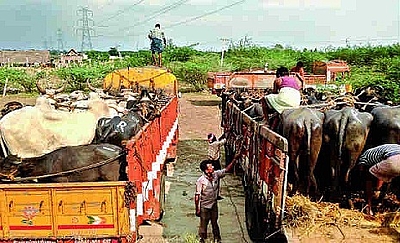 |
The Advocate General said that the Maharashtra Animal Preservation (Amendment) Act was enacted as per the Constitutional mandate and to ensure prevention of cruelty to animals. A division bench of Justice V. M. Kanade and Justice A. R. Joshi inquired why the state had only banned the slaughter of bulls and bullocks and not goats. The AG responded: "We have made a start with cows and its progeny. At least we have made a beginning. The state might consider others." The HC has directed the state to file an affidavit explaining its stand, especially with regard to section 5D, which is at the root of the challenges in the petitions heard by the court. The 5D provision makes it a crime to possess the flesh of bulls, bullocks and cows, even if they are slaughtered outside Maharashtra. The AG defended the law against attacks from the petitioners who claim that it violates the right to eat, that is a part of the fundamental right to life. "The state is against the slaughter of cows, bulls and bullocks and the possession of its meat for any purpose, including consumption. The state wants it to be stopped," said advocate Manohar. The court then questioned the purpose of the law. "Indirectly, aren't you preventing people from consuming something which is part of their food," asked the judges. To this the AG replied, "The law is based on the directive principles of the Constitution that seek prevention of slaughter of cows as well as the rules that seek prevention of cruelty to animals. The purpose is to promote a sense of sympathy in citizens for such animals. If it deprives some people from consuming beef then that is just incidental." This February, President Pranab Mukherjee had sanctioned changes to the Maharashtra Animal Preservation (Amendment) Act. While the old law notified in 1976 banned the slaughter of cows, the new changes banned slaughter of bulls and bullocks as well. The sale of bulls, bullocks for slaughter has been made a crime, which is punishable with a jail term of up to five years and a fine of Rs 10,000. The possession of meat of a cow, bull or bullock is also an offence which can be punished with one-year imprisonment and a fine of Rs 2,000. Senior advocates Aspi Chinoy and Navroze Seervai, who represented one of the petitioners, senior advocate Haresh Jagtiani, claimed that the new law was a serious invasion of fundamental rights and did not fit in with the stated purpose of the law. They urged the court to strike down section 5D which criminalizes even possession of beef, claiming that the right to eat was a part of the right to privacy, which in turn was a part of the right to life guaranteed under the Constitution. Lawyers Firoze Bharucha and Pratap Nimbalkar, who represented Jogeshwari resident Arif Kapadia, pointed to the fact that while meat of cows, bulls and bullocks were banned, there was no similar ban on the hide of these animals being brought into the state to make leather products. SHRI ANANDJI KALYANJI PEDHI IS MAKING SHATRUNJAY GIRIRAJ AS NO PLASTIC ZONE As per the instruction issued by the administrators, Shri Anandji Kalyanji Pedhi, nobody is allowed to carry any plastic bags during Yatra to hills. Even plastics bags containing sweets and fruits are also not allowed to be carried. All yaatris are strictly checked. Really a laudable action on the part of temple management. Other Jain Temples also may take inspiration. GOATS SLAUGHTERED IN FRONT OF JAIN DERASAR IN GOPIPURA, SURAT May 5th, 2015. Surat. Goats were slaughtered in front of Jain Upashraya in Gopipura area of Surat on Monday. The incident hapened near Kazi Maidan where Samruddhi apartment, Navkar apartment, Ambika apartment and Meghganga apartment are situated along with two Jain Upashraya.One Rizwan had called butchers to his house and managed open slaughter of goats keeping the gate of his house open to public view. One teen-age Hindu girl who incidentally watched this scene was so frighten that she fainted when returned to home. As local people gathered outside Jain Upashraya after this incident, Athwa Police also rushed to the place and detained Rizwan and a butcher. Police booked house owner for breach of notification, as he had not informed police about Rizwan whom he had rented his house. It has to be mentioned that two Jain Upashraya in Gopipura area have suffered stone pelting from local Muslims in the past as Jains in this area prefer to not to sell their property to Muslims here for obvious reason that Jain Derasar and Upashraya are located here. While Jains believe in non-violence and compassion towards all including animals, Muslims slaughter animals for food. 100-YEAR-OLD VEGAN HEART SURGEON DR. ELLSWORTH WAREHAM CREDITS DIET WITH LONGEVITY
 |
Want to live to be 100, without the plague of chronic diseases and decrepitude? Eat a healthy vegan diet! That’s the message of Dr. Ellsworth Wareham, a 100-year-old vegan heart surgeon who credits a plant-based lifestyle for his health and longevity.
In one of his interview to CNN he revealed that he worked until age 95, he still drives and, apparently, mows lawns. “If you were to give me something to memorize, I would memorize it just as quickly now as I would when I was 20,” he told CNN’s Dr. Sanjay Gupta.
He credits his plant-based diet for his health and wellbeing. “If your blood cholesterol is under 150 your chances of having a heart attack is pretty small.” “So you’re heart attack proof?” Gupta asks. “I’m dealing with an area in which I understand,” he responds. Watch the interview here
JAIN TEMPLES
THEFT AT PALDI JAIN TEMPLE
Apr. 29th, 2015. Ahmedabad. Nilesh Shah, 44, who is in charge of the management of a Jain temple at Bhavi Avenue in Paldi lodged a complaint about a theft of valuables at the temple with Ellisbridge police. Shah's wife Rajulben dutifully opens and locks the temple, Sumatinath Gruh Jinalaya Derasar's doors every day. On April 10, Rajulben locked the temple doors around 8 pm. Around 6 am on April 11, two devotees Shripal bhai and Umag bhai visited the temple. They immediately called up Shah and told him that a theft has taken place at the temple. When Shah reached there, he found that the temple's lock was broken and panchdhatu statues of Shantinath Bhagwan Siddhachakraji Bhagwan, Ashtamangal murti, and a silver umbrella embedded with diamonds were missing. Police said, "The accused will be booked under Sections 454, 457 and 380 of the IPC.
JAIN SAINTS
मुनि श्री यश सागरजी आचार्य श्री वर्धमान सागरजी से सल्लेखना लेते हुए
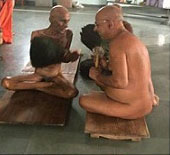 |
मालूम हो की मुनिश्री ने स्वास्थ की प्रतिकूलता को देख करके आचार्य श्री के निर्यापकत्व में सल्लेखना व्रत धारण करने की प्रार्थना दिनाक 4 मई को की थी। मुनि श्री ने पेय आहार छोड़कर तीन प्रकार के आहार का त्याग कर नियम सल्लेखना को धारण किया था। मुनि श्री ने पुरे भक्ति भाव एवम् प्रसन्न चित्त होकर समस्त संघ से क्षमा याचना की।मुनि श्री पूर्ण चेतना एवम् पञ्च परमेष्टि के स्मरण में दत्तचित्त थे। मुनिश्री ने 29 अप्रैल 2015 को ही वात्सल्य वारिधि आचार्यश्री से मुनि दीक्षा ग्रहण की थी और उन्ही के चरणों में समाधी हो गई।बीसवीं सदी के प्रथम दिगम्बराचार्य चारित्र चक्रवर्ती आचार्य श्री शांति सागर जी महाराज की परंपरा के वर्तमान पंचम पट्टाचार्य परम पूज्य वात्सल्य वारिधि आचार्य श्री 108 वर्धमान सागर जी महाराज से दीक्षित मुनि श्री यश सागर जी महाराज की समाधी पूर्वक देवलोक गमन हो गया।अंतिम यात्रा, दिनांक.05.05.15, स्थान.आदिनाथ कालोनी, किशनगढ़;राजण्द्।
जैन मुनि के बयान पर दारुल उलूम का ऐतराज
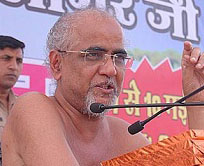 |
May 12th, 2015. जैन मुनि तरुण सागर महाराज के लव जिहाद पर दिए गए कड़वे प्रवचन से यह मुद्दा एक बार फिर से गरमा गया है। बयान को लेकर जहां उलमा ने इस तरह की बयानबाजी को माहौल को गरम रखने वाला बताया।वहीं दारुल उलूम ने कहा कि प्रतिक्रिया की सियासत पर वे विश्वास नहीं रखते। ‘लव जिहाद हिंदू लड़कियों को मुसलमान बनाने का षड्यंत्र है। सरकार इसे पहचाने नहीं तो वह दिन दूर नहीं जब एक और पाकिस्तान बन जाएगा।’ जैन संत तरुण सागर के इस बयान पर देवबंदी उलमा ने कड़ी प्रतिक्रिया दी है। दारुल उलूम के मोहतमिम मौलाना अबुल कासिम नोमानी बनारसी ने कहा कि दारुल उलूम शैक्षिक इदारा है जिसका राजनीति से कोई संबंध नहीं है। जहां तक तरुण सागर महाराज के बयान का सवाल है तो हम प्रतिक्रिया की सियासत पर विश्वास नहीं रखते हैं। दारुल उलूम वक्फ के वरिष्ठ उस्ताद मौलाना मुफ्ती आरिफ कासमी ने कहा कि लड़का-लड़की का आपस में प्यार मोहब्बत होना धर्म और मजहब से इसका कोई ताल्लुक नहीं है। टेलीविजन पर आने वाले सीरियल और फिल्में इसके लिए जिम्मेदार हैं। बोले, जैन मुनि की अक्ल पर मातम करने को दिल करता है। मुफ्ती आरिफ ने कहा कि माहौल को गरम रखने के लिए आरएसएस की जहनियत वाले लोग इस प्रकार की बयानबाजी कर रहे हैं।
EVENTS, CONFERENCES
ONE JAIN - TO COORDINATE BETWEEN ALL JAIN GROUPS IN UK
The Institute held a historic meeting of all Jain organisations in the UK, Chaired by Dr Abhay Chopada, with a view to take a lead in representing the Jain faith in all Government and inter-faith matters in the UK. This was to ensure that Jains in the UK and Jainism had a single, coherent voice and that they received the recognition and participation they rightly deserved under the banner of ONE JAIN.
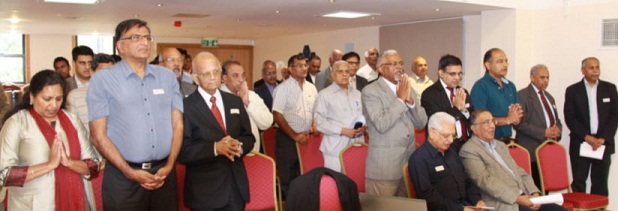 |
All organisations present at the meeting unanimously passed a resolution stating: “The Jain Organisations in the UK hereby resolve that the Institute of Jainology is entrusted with the task of leading the One Jain vision in the UK and providing a unified voice for Jainism in the UK involving other organisations as necessary to promote the common cause of Jainism”.
The Institute of Jainology, a registered Charity, run by a group of nine Directors on a voluntary basis; have in the past organised and represented Jains at a number of national and international events. This has raised awareness of the faith, doctrine and scriptures on a global platform. There are almost 30 Jain Organisations in the United Kingdom representing approximately 30,000 Jains. The largest organisation with over 15,000 members is Oshwal Association of the UK based in Potters Bar followed by Navnat Vanik Association of the UK with over 5,000 members based in Hayes, London. Other small organisations are scattered around the country. All organisations are registered with the Charity Commission in the UK. Whilst all the Organisations celebrate all Jain festivals and rituals in their own way, they have lacked the resources to represent the Jain faith at an international level.
Since this historic meeting, the One Jain has carried out the following activities
1. Circulated regular informative Circulars from various Government and Interfaith organisations
2. Met the Indian High Commissioner to highlight the problems experienced by the local nations in obtaining India visas. Several actions taken - including arranging a regular surgery
3. Organised a workshop on issuance of Business Visas for the religious visitors to the UK
4. Arranged a visit by H R H The Prince of Wales to Oshwal Centre and awarded him a special Ahimsa Award. This created an opportunity for many Jain community members to meet HRH.
5. Met the annual financial obligations of Jain Organisations with Interfaith Network of the UK by arranging collections from individual organisations
A second meeting was held on Sunday 12 April, 2015 chaired by Dr Mehool Sanghrajka, where leaders of a few Jain organisations presented their own future projects and a list of actions until the next meeting were discussed. Information Source: Mr. Kanti Shah, E-Mail:
PARICHAY SAMMELAN ORGANISED BY BHARATIYA JAIN SANGHATAN, BALLARI
 |
Bharatiya Jain Sanghatan of Ballari has organised a Matrimonial Parichay Sammelan for widows, divorcee, physically handicap & re-marriage cases on 31-5-2015 Sunday at BDAA Football Ground, Ananthpur Road, Ballari (Karnataka). Men and women (Jains only) in the age group of 30 to 40 years can participate. Last date for submitting application with supporting documents: 20-5-2015. For further details pl Contact: Sri Kanthilal Parekh - 9448006725 or Sri Padam Mehta: 9845025161. Application forms can also be downloaded from www.bjsindia.org
HONOURS AND AWARDS
C A R. M PARAKH HONOURED WITH 2015 PRAVASI BHARITIYA AWARD 2015
Rajmal Parakh headed one of the largest group in Middle East with the annual revenue of over US$5 billion and group companies which was started from the scratch, and took it to the zenith of its success with his dynamic management, but also contributing enormously to further development of his India-based company, the Biogenomics Ltd., a front-runner in innovation-driven enterprise being focused on the development, production and marketing of Biogenerics and Biosimilars. It is a bio-tech enterprise involving high-end critical research for Cancer, Rheumatic and Diabetes etc.
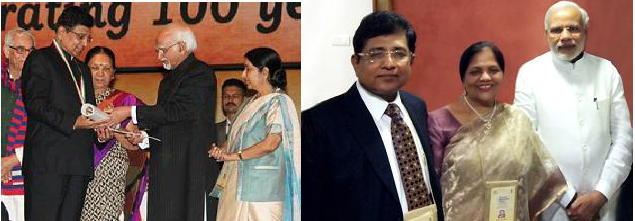 |
Mr. Parakh has also been a leading philanthropist, doing various community services and charitable work in his host land as well as his motherland, India. With his deep humanistic concern to rescue the downtrodden sections of the society in Oman as well as India from the curse of poverty and inaccessibility to proper education and healthcare, Mr. Parakh is found to be among the top philanthropists devoutly engaged in the work, seeking to relieve the distressed humanity.
In the year 2000, he set up a private Charitable Trust for social work and philanthropic activities. His charitable trust is engaged in charity work, especially in Oman and India - Jodhpur, Jaipur, Mumbai and Delhi. In Oman, he helps the deprived people by offering medical facilities. In case of natural calamities, he provides the victims the cost of air travel for their repatriation. Besides, he also helps the mentally retarded children for their treatment and well being. The corpus of the trust as of now is Rs. 21 Crores.
During the recent Uttarakhand tragedy, Mr. Parakh had helped in various manners like construction of the houses and providing shelters & other facilities in two villages on the Gori Ganga river valley of Pithoragarh district, Uttarakhand and during the devastating earthquake in Gujarat, Parakh has been a major contributor and his relief work was well appreciated by the Prime Minister's office for the valuable help rendered by him during those days of ordeal.
Parakh has also helped and assisted in contributing Rs.14 Crores to a Charitable Hospital in India. He has also contributed good amount for blind children schools and has been donating regularly to various charitable organizations, hospitals, eye cataract camps and polio camps etc. so that even the people below poverty line who could not afford costly medicines can have access to good health care facilities at these hospitals. He has also offered merit scholarships to students who are economically weaker and can't afford the expenses of higher education.
He is significantly contributing every year to orphanage and other charitable societies to provide solace to the poor and physically challenged persons, helping them in living a life of dignity. He has also helped in providing clean drinking water in backward Tribal villages in Thane, Maharashtra through a charitable trust in Mumbai. His recent initiative is on setting up “Centre of Excellence” in Jodhpur (Rajasthan) which will provide opportunities to underprivileged children for their higher education and for their preparation to compete various competitive exams.
He was also a founder chairman of Muscat Chapter of institute of Chartered Accountants of India from the year 1989-1994. He was Chairman of Board of Directors of Indian Schools in Oman during the year 2001-2002 an apex body comprising 20 Indian Schools having strength of over 20,000 students at that time. He is the Chairman of the “All India Vegetarian Foundation”.An unofficial diplomat acting from behind the veil, he has been playing a major role in further improvement of Indo-Oman bilateral relations, pursuing and helping both the Private Sector companies to come closer, thereby creating a salubrious ambience for development of commerce and trade and opening further avenues for employment among the youths.
In recognition of Mr. Parakh's contributions in the field of social services, he was awarded with “Lifetime Achievement Award” for the year 2009 at the Annual Global Summit of NRI Institute held at Doha, Qatar in March 2010 by Dr. Farooq Abdullah, India's Union Minister for New and Renewable Energy. In 2015 he was awarded by Indian Government with “ Pravasi Bhartiya Samman Award 2015 which is the highest award for the NRIs and PIOs.
He is born and brought up in Jodhpur, Rajasthan. He is first among NRI PIO Chartered Accountant in the world to receive this award and second Jain Fraternity Member in the world to be honoured with “ Pravasi Bhartiya Samman Award”.
50TH JNANPITH AWARD GOES TO MARATHI NOVELIST BHALCHANDRA NEMADE
Apr. 26th, 2015. New Delhi. Modi awarded the 50th Jnanpith Award to eminent Marathi litterateur Bhalchandra Nemade whose several books, including Kosala and Hindu, have influenced Indian writing. As a critic, Nemade's contribution rests in initiating Deshivad, a theory of nativism that negated globalisation, asserting the value of a writer's native heritage, and language.
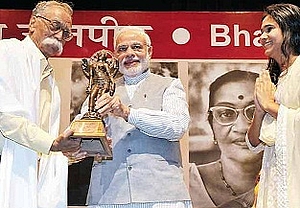 |
Trishla Jain, daughter of Samir Jain, Vice Chairman and Managing Director of Times Group, said the award has been serving to reward the finest in Indian literature since its inception in 1943 in Varanasi. Writers, she said, are not only chroniclers of times but are also conscious keepers of the society and need to be encouraged.
Measures such as government accommodation for writers in different cities, insurance and subsidised travel could help the writers spread the benefit of their intellect to a larger audience, suggested Jain, who began her address with a prayer for the victims of the Nepal earthquake. She also stressed the need for facilitating more translations of Indian writing so that it is celebrated globally.
Seventy-six-year-old Nemade, who hails from Jalgaon, spoke about the need for the Indian society to stop thinking that progress would come only with adopting foreign influences. What we need is a reverse acculturation to counter the belief that "the soil can be ours but the seed has to come from outside." Deshivad, Nemade said, was an essential requisite for every writer. "There is always a question how much is deshivad and what stretch could make it fundamentalism. But in our tradition, there is no scope for it becoming a stretch, there are checks and balances.
"Trishla Jain said it was an honour to have PM Modi as a guest at the event and reminded him that it was in Benaras, his Lok Sabha constituency, that the Jnanpith Award was conceptualised by her great grandparents, Rama Jain and Sahu Shanti Prasad Jain. She said that the 50th anniversary of the Jnanpith award was also a time to pay tribute to those who are instrumental in the inception of the award that rewarded the finest in Indian literature.
Prime Minister Narendra Modi speaking on the occasion said, it was a matter of both admiration and surprise that the Vedas written several years ago had solutions to problems mankind was facing today. Extolling the contribution of writers to society and stating how some forms of literature live on to influence generations, most often connecting the present and past with the future, he said, "It is quite admirable that the vedas contain solutions for problems of global warming and environment protection, issues that we face today. But who wrote them belonged to that time.
"SUPRIYA SHARMA WINS PRESTIGIOUS CHAMELI DEVI JAIN AWARD
 |
Mar. 16th, 2015. Scroll.In's Supriya Sharma is the recipient of the Chameli Devi Jain Award for an Outstanding Woman Journalist for the year 2014-'15. "Ms Sharma was chosen for her well-crafted reportage which the jurors felt focused not only on the neglected and the marginalised but also on contemporary issues," said a press release by The Media Foundation, which administers the prize.
Supriya Sharma is the first online journalist to win the prize, which is named after freedom fighter Chameli Devi Jain. For 35 years, it has been recognising women journalists who have upheld standards of excellence through a sustained body of work.
Over the last year, Sharma has undertaken several rigorous reporting projects.
Just before the 2014 national elections, she set out on a 2,500-km train journey from Assam to Kashmir, aiming to find out about what Indians thought about their politicians and what they wanted from their new government. Read the Window Seat series here. The award was presented on March 19 at Delhi's India International Centre auditorium.
ARUN JAIN HONOURED WITH VISIONARY OF INDIA AWARD
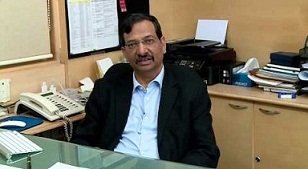 |
Apr. 21st, 2015. Chennai. Arun Jain, Chairman and Managing Director of Intellect Design Arena (a Polaris Group company), has been honoured with the Visionary of India 2014-15 award, instituted by NexBrands, for his 'Digital Transformation' vision in the financial technology sector. Receiving the award at the Brand Vision India 2020 Summit & Awards held in Mumbai, Arun Jain said,
"I am delighted and honoured to receive this title as I have always believed that we could drive disruptive innovation through products and solutions designed and made in India for the world. This recognition asserts the fact that we are indeed looking to create the next Silicon Valley out of India." According to an official statement, Arun Jain, who led the creation of Intellect Design, the demerged banking products company of the Polaris group, believes that in a span of next 10 years, India will be able to generate a $100 billion IT product output. Jain's focus on the BFSI sector and a philosophy of design thinking have led to the creation of 8012FT Design Centre, a one-of-its-kind financial technology design centre. 'Brand India Vision 2020', an annual initiative, recognizes 'Visionaries of India', those innovating in various sectors and transforming the Indian economic and social outlook.
SATYA PAL JAIN APPOINTED ADDITIONAL SOLICITOR GENERAL IN P&H HIGH COURT
 |
April 17th, 2015. Chandigarh. Former Chandigarh MP and Senior Advocate Satya Pal Jain has been appointed as Additional Solicitor General of India by the Union Government.A notification was issued appointing him as the Additional Solicitor General in Punjab and Haryana High Court for three years. It is for the first time that the post of Additional Solicitor General has been created in Chandigarh by the Centre. Satya Pal Jain has been the all India in-charge of the legal cell of BJP for around 10 years. A noted constitutional lawyer, he has represented the BJP in various important politico-legal battles like the Liberhan Commission, Karnataka defection case, HJC defection case and others. He has also been representing various senior leaders of the party, including Prime Minister Narendra Modi, L K Advani, Sushma Swaraj, Shanta Kumar, M Venkaiah Naidu, Navjot Singh Sidhu and Prem Kumar Dhumal in various courts of the country. He was elected to Lok Sabha from Chandigarh in 1996 and 1998, defeating former Railway minister Pawan Bansal.
BOOKS
UNDERSTANDING JAINISM LAWRENCE A. BABBBY Willem Schupf, Professor of Asian Languages and Civilizations and Professor of Anthropology, Emeritus, Amherst College, Massachusetts
 |
This book is designed to be an introduction to Jainism as a religious tradition and way of life. While paying due attention to Jainism's history and doctrinal basics, the book also emphasizes the ways in which formal Jain teachings are Ëœmanifested in the practices of both laity and the monastic elite. In addition, the book explores the distinctive Jain systems of cosmographic and biological knowledge, and it describes how Jainism is woven into the social identities of Jain communities in modern India. According to Author, Jainism is Buddhism's often overlooked cousin.
As the only surviving examples of ancient India's non-Vedic religious traditions, these two religions are often grouped together as 'heterodoxies,' but this is to ignore deep differences between Jain and Buddhist beliefs and practices. Unlike Buddhism, Jainism has hardly spread beyond the Indian subcontinent. Yet, unlike Buddhism, Jainism has survived in India where it is a prominent element in the mix of Indian religions today. Although relatively few in numbers, the Jains are a wealthy community and exercise great influence in Indian economic and political life.Copies are available from Dunedin Academic Press, C/o Turpin Distribution, Pegasus Drive, Stration business, Park, Biggieswade, SG188TQ, UK (http://ebiz.turpin-distribution.com) E-Mail: c Tel:+44 (0) 1767 604951, In North America: from international Specialized Book Service www.isbs.com
MISCELLANEOUS
RARE JAIN MANUSCRIPTS WITH UP GOVERNMENT NEED COMMUNITY CARE
Allahabad. Sangam City is a proud custodian of rare manuscript of a scripture related to `Agamas` or `Shastra` of Jainism based on Lord Mahavir`s teachings. A few of its verses are even coated with gold. The script of this rare invaluable manuscript is yet to be deciphered.
Experts believe that the text could be in the oldest spoken language of `Prakrit`. However, few others believe that the script could also either be Sanskrit, Oriya or Bengali. The manuscript, currently in the possession of state`s only Government Manuscript Library, has remained out of public eyes owing to paucity of fund. For record sake, the library has been safeguarding the manuscript for the last 55 years. Due to lack of proper conservation and preservation technique, several lines of `verses in gold` faded away in 1987. Later, the then officials re-wrote the missing part with yellow ink. Currently, the Regional Archive Officer has the additional charge of the library owing to absence of experts. According to a Library Officer, manuscript kept at library was in Prakrit language prevalent among common masses around 2,000 years ago, its composition in writing started around 10th Century AD. The minute gold work started in later period so its date could range from 1500 to 1600 AD," added Agnihotri.
JAIN POPULATION IN INDIA
As per Census 2011 Total Jain population in India is about 42 lakhs of which Maharashtra has the the highest Jain population with more than 11 lakh Jains, followed by Rajasthan with 6.5 lakh Jains and Madhya Pradesh with about 5.5 lakh Jains. Gujarat is at 4th position with 5 lakh Jains. Andman and Nicobar Islands have a total of 23 Jains. Highest Literacy Rate is in Andman and Nicobar Islands where all the 23 Jains are educated followed by Chandigarh With a Literacy Rate of 97.3. Delhi and Chattisgarh have a Literacy Rate of 96.8, both occupying the 3rd position. Most Illiterate Jain population is found in Mizoram where only 61.7 % Jains are Iiterate. Daman and Diu has the best Sex Ratio of 1000 Females per 1000 Males, followed by Kerela with 996 and Gujarat with 969 Females per 1000 Males. Arunachal Pradesh has the lowest Sex Ratio of 662.
JAIN TRADE ORGANISATION TO HELP YOUNG MEMBERS ENTREPRENEURS
 |
April 15th, 2015. Chennai. In an effort to retain talent, the Jain International Trade Organisation (JITO) in Chennai is planning to open a Consultancy Centre to help Young Entrepreneurs raise funds from Angel and Venture Capital Investors. The Advisory Committee will consist of five Chief Executive Officers (CEOs) from Sebi-registered Alternate Investment Funds. Jaswant Munoth, who took charge as the Chairman of the JITO Chennai Chapter, said that the Consultancy will help Youngsters become job creators instead of job seekers. The Organisation also signed a Memorandum of Understanding (MoU) with Apollo Hospitals to provide free surgeries to economically weaker Jains besides launching a co-branded health card for JITO members. It is also planning an education assist programme together with 11 colleges in Tamil Nadu to provide scholarships to students.
WOMAN JOURNALIST TOLD NOT TO SIT NEAR MONKS AT JAIN FUNCTION, SHIV SENA SEEKS APOLOGY
May 1st, 2015. Mumbai. A woman journalist being asked to shift from the front row reserved for media to make way for monks at a function to felicitate Chief Minister Devendra Fadnavis triggered a controversy with a Shiv Sena leader demanding an apology from the event organisers. Rashmi Puranik, working as a reporter with a Marathi news channel, was among the first to reach the venue where Fadnavis was felicitated for banning cow slaughter in the state.
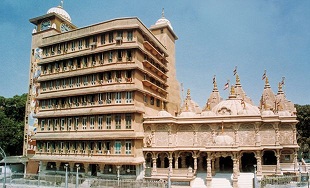 |
She occupied a seat in the front row reserved for journalists. However, she was asked to shift behind in the area allocated for women. She was informed that women do not occupy front seats in presence of monks, so she had to move behind.
However, the organisers and community members which organised the event, said there was no discrimination among castes or men and women in Jainism. They even mentioned that, according to Bhagwan Mahavir also all living beings should be equal treatment. There is no question of insulting women. Seating place for women was marked. So we only requested the woman reporter to the marked area.
When Fadnavis came to know about the incident, he said in his speech at the function that discrimination against women was not a good sign for a healthy society. "We are in the 21st century. We need to work towards a progressive society and this can happen only if women and men are treated equally," the Chief Minister said. Meanwhile, terming such incidents as "unacceptable", Shiv Sena leader Neelam Gorhe sought an apology from the organisers of the event. Gorhe also said that the religious sect should accept the contradictions within its system and try to change it. Pointing out that there are different beliefs in different faiths, she said, "In the present times, when religious rites are conducted by women, such incidents are unacceptable" and cited that there are women saints as well. There are many obstacles and hurdles for women's development in financial sector, social and cultural fields as well as politics, she rued.
DEVLOK GAMAN
JAIN SADHVI YASH KANWAR PASSED AWAY
Bhilwara. 99-year-old renowned Jain Sadhvi Yash Kanwar maharaj left for her heavenly abode in Bigod town. She was ailing since a long period and stayed with other Sadhvi's in Jain Upashray at Bigod since last three years.ft for. Her funeral procession started from Bigod and went on to Bhilwara. The final rites were performed at Bhilwara town. Thousands of her followers reached to Bhilwara to pay respects to her. The body was kept at the Jain Upashray at Bigod for people to pay last tributes. She was born in 1916 in a Vaishnav Bairagi family of Jat village(Madhya Pradesh) and took Jain Sadhvi Diksha when she was 20 year old in 1936 at Begun in Chittorgarh district in presence of Jain saint Kajodi Mal, Bhura Lal Maharaj. In late 1970's, She took a big step and stopped animal sacrifice in Jogniya Mataji temple in Khairad sand stone area (Chittorgarh to Kota, dane forest area) where robbers and dacoits ritually do killing and offer the animal to appease their deity during Navratri. She bound them not to do animal killing in the name of deity.
JAIN SADHVI RIDHITA SRIJI DIES AFTER FALLING IN RIVER
March 19th, 2015. Vadodara. A 30-year-old Jain Sadhvi reportedly committed suicide after she jumped off a bridge into the Mahisagar river. The incident took place near Bamangam village of Padra Taluka in which the Jain nun, identified as Sadhvi Ridhita Sriji Maharaj, died. The victim, who was part of a group of Sadhvis which was on its way to Padra on foot, was left behind due to fatigue and while crossing the bridge she jumped into the river. She had also undergone a surgery for kidney stone and was not keeping well. The dead body was recovered and handed over to the members of the Jain community at their request without postmortem.
OBITUARY
FORMER DELHI HC CHIEF JUSTICE MILAP CHAND JAIN DIES
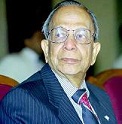 |
May 1st, 2015. Former Chief Justice of Delhi High Court Milap Chand Jain died at his residence here after a brief illness. Mr. Jain, who was also the Lokayukta of Rajasthan, died at the age of 86.He is survived by his son and two daughters. His last rites were performed at a crematorium in Shyam Nagar, Jaipur. Rajasthan Governor Kalyan Singh and Chief Minister Vasundhara Raje condoled the death of Mr. Jain. Floral tributes were paid to Mr. Jain on behalf of Rajasthan Governor. In her condolence message, Chief Minister Vasundhara Raje praised Jain’s “effective and impressive” style of functioning.
ARTICLE OF THE MONTH
SANTHARA: CONFUSION GALORE!
By Surendra Bothra
Santhara is neither a cause nor an instrument of death. It is a name given to the last part of an elaborate Jain spiritual practice called Sallekhana or Samlekhana (ultimate vow). The meaning of the term Sallekhana is: to properly emaciate passions and body. Santhara literally means a bed of hay; the practice derives the name because when the time of death approaches the aspirant sits or lies down on a bed of hay renouncing all possessions, attachment and intake. The reflection of this practice can be seen in every household when a person is brought down from his cot to a mattress on the ground during presumed last moments of his life.The oldest, authentic and first mention of Sallekhana is found in Acharanga Sutra, accepted by Shwetambar Jains as the first sermon of Bhagavan Mahavir. According to philologists the first Shrutskandh of Acharanga Sutra depicts the earliest phase of Jainism of about 3 rd century BC. It is the oldest available text in Jain tradition. All other discussions about Sallekhana belong to later periods. Here is what Acharanga states........to read further.
"If an ascetic realizes that now it is gradually becoming impossible for him to sustain the body for his essential (ascetic) duties, he should gradually reduce his food intake through austerities. While reducing the food intake he should also reduce his passions. After reducing passions he should acquire mental serenity. Becoming thin by honing both sides, body and passion, like a plank of wood, that ascetic should make himself stable (free of agitations of body and mind) and rise (prepare to embrace meditational death or Samadhi Maran). If that ascetic has enough energy to walk, he should go to a village, city,........ or capital (any populated place) and beg for hay or a stack of straw. When he gets a stack of straw he should retire into seclusion........ He should then thoroughly clean that spot and make a bed of straw (Santhara) there. Now he should occupy the straw-bed and observe itvarik fast (fasting for a predetermined period)." (Acharanga Sutra 8/6/225).
There is a code defining conditions and circumstances when this spiritual practice can be accepted. " Sallekhana is done in circumstances like drought, old age, incurable fatal disease, and gradual depletion of the strength of the body." (Ratankarandak Shravakachar 122).
Unlike suicide that is done in an agitated state of mind, Sallekhana is accepted in a peaceful state of mind and after much deliberation as well as seeking permission from family members and the guru. According the commentary on Acharanga Sutra there are two special provisions - 1. If an ascetic observing sallekhana practices gets sick, unconscious, or dizzy due to lack of food and nutrition, he should stop rigorous austerities, terminate the sallekhana process and accept food. 2. If he develops an aversion for food or has lack of appetite, he should give up food.
The practice loses its spiritual value if there is intent of death at any time during this practice. In fact desire for death is listed as one of the faults in practice of Sallekhana. "An ascetic, who is practicing sallekhana or anashan, should neither desire to live nor pray for death. He should remain detached both from life and death (Acharanga Sutra 8/8/233).
Sallekhana is a spiritual practice dissociating one's mind from the body in order to attain a tranquil and equanimous state of mind; something like Samadhi. Death in such serene state of mind is classified as Samadhi maran (meditational death), which is common to almost all religions. In this practice there is no invitation to death. It is, in fact, detached and serene acceptance of the inevitable. The only connection Sallekhana has with death is that it is a practice, preparatory to advancing toward the end, employed in terminal conditions.
In medical parlance it is nearest to the condition of a patient in painful terminal condition put on sedatives. Doctors say that nothing can be done to cure him. They just inform him about an estimated survival period, stop almost all treatment and leave the patient to his own fate. Heavy dosage of sedatives is given neither for cure nor for prolonging life but to reduce his suffering. In other words, they try to put the patient, awaiting death, in a tranquil state of mind. Sallekhana is similar to this condition. The difference is that the former is induced by a drug and is a state of stupor. The latter is self induced and fully conscious state; something like self-hypnosis.
It is also something like extended practices of chanting mantras or holy words to a dying person, feeding holy water to a dying person, taking the patient for a pilgrimage, and many other such practices of providing peaceful and pleasant atmosphere prior to death. These practices in one form or the other are common to all religious and social communities throughout the world. Opposing such time tested religious and social customs legally or socially could be termed as sentiment-driven acts mostly based on ignorance. They tend to end as damp squibs if not back-fire.
Death is inevitable and unpredictable. It may occur at any time and in any circumstance. Can we prohibit all activities that were being done just before death? Every act, condition or state preceding death cannot be branded as instrumental to death, killing or suicide. If this happens, all acts of tapasya, sadhana, and even medical and surgical interventions where rate of survival is less than 20 percent (some cases of neurosurgery) will have to be called attempt to suicide or kill.
As happens with any form of institutionalization such codes and practices undergo regression and turn into rituals with passage of time. The basic principle is distorted or completely lost. The practice of Santhara we see today, in some or many cases, could just be a socially imposed glorified ritual but for that the basic principle or the code based on it should not be blamed and thrown away. What is needed is educating people about the true prescribed process, the principle on which it has been founded and its deemed advantages. Along with that, answers to some questions should be sought before trying to interfere with this accepted and healthy religious practice designed to instill courage and serenity in face of the agonizing horror of impending death:
When it is a voluntary and self administered act, how can it be called killing? Is it possible and practical to put every terminal patient in hospital on life support system? Does it happen? Why not compare the rate of death of ailing patients and the life support systems available in hospitals throughout the country? Fasting is a very common practice among Jains. Fasting even for a much longer period than reported in cases of Santhara is very common. How fasting by Jains can be branded as a method of suicide? Moreover, why not find out how many cases of suicide attempts by fasting have been reported all around the world?
When it is not killing and when it is difficult to call it suicide why oppose it? Why not undertake religious, social and legal studies before taking such impulsive steps?
Courtesy: Surendra Bothra, 3968, Rasta M. S. B, Jaipur, Rajasthan - 302003, E-Mail:
JAIN CALENDAR - MAY 2015
VIR SAMVAT 2541 JAIN CALENDAR VIKRAM SAMVAT 2071
| Aatham| Chaudas | Pancham | Bij | Agiyaras | JainFestival | ; | Auspicious Day |
CHAITRA - APRIL 2015 - VAISHAKH | ||||||
| Mon | Tue | Wed | Thu | Fri | Sat | Sun |
| VAISHAKH: 1 TO 18 MAY JETH: 19 TO 31 MAY | 1 Sud Teras | 2 | 3 Sud Chaudas | |||
4 | 5 | 6 | 7 | 8 | 9 Vad Pancham | 10 |
11 | 12 | 13 | 14 | 15 | 16 | 17 |
18 | 19 | 20 | 21 Sud Choth | 22 Sud Pancham | 23 Sud Pancham | 24 Sud Chhath |
| 25 Sud Satam | 26 Sud Aatham | 27 | 28 Sud Dasam | 29 Sud Agiyaras | 30 | 31 |
AVOID GREEN & ROOT VEGETABLES |
